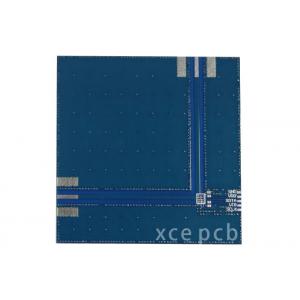

Add to Cart
60GHz Receiver And Transmitter Module 0.508mm 2oz copper pcb Board
, Blue Soldermask
Quick detail:
| Origin:China | Special: Taconic material |
| Layer:4 | Thickness:0.79mm |
| Surface: ENIG | Hole:0.8 |
TACONIC company is the world's largest production of PTFE CCL
manufacturer, with a glass woven cloth coated with PTFE patent, is
the PTFE microwave CCL industry, one of the technology leader, and
its microwave CCL's dielectric constant To 2.17-10.0, occupying the
global antenna sheet market share of more than 80%.
TACONIC high-performance insulation materials for the microwave,
radio frequency (RF) and high-speed digital signal processing
market PTFE / woven glass fiber woven sheet. This material can be
used in LNAs, LNBs, PCS / PCN antenna systems, Global Positioning
System (GPS) and UMTS antenna systems, as well as power amplifiers,
passive components, collision avoidance radar systems, aeronautical
telemetry and phase control Array radar system.
High Speed Design Frequency PCB Board Special high electromagnetic frequency circuit boards, in general,
can be defined as the frequency of the high frequency of 1GHz. Its
physical properties, precision, technical parameters required is
very high, commonly used in automotive anti-collision systems,
satellite systems, radio systems, etc.
The basic characteristics of a high frequency board material
requirements are the following:
(1) dielectric constant (Dk) must be small and very stable, usually
the smaller the better signal transfer rate and the dielectric
constant of the material
Inversely proportional to the square root of high dielectric
constant is likely to cause the signal propagation delay.
(2) the dielectric loss (Df) must be small, mainly affect the
quality, the smaller the dielectric loss signal transmission of the
signal loss is smaller.
(3) as far as possible consistent with the coefficient of thermal
expansion of the copper foil, copper foil separated because of
inconsistency will cause changes in the hot and cold.
(4) to low water absorption, high water absorption will affect the
dielectric constant and dielectric loss when damp.
(5) Other heat resistance, chemical resistance, impact strength,
peel strength, etc. must also be good.
Microwave Antenna 4 Layer PCB Board,Radio frequency (RF) and microwave PCB’s are a type of PCB designed
to operate on signals in the megahertz to gigahertz frequency
ranges (medium frequency to extremely high frequency). These
frequency ranges are used for communication signals in everything
from cellphones to military radars. The materials used to construct
these PCB’s are advanced composites with very specific
characteristics for dielectric constant (Er), loss tangent, and CTE
(co-efficient of thermal expansion).
High frequency circuit materials with a low stable Er and loss
tangent allow for high speed signals to travel through the PCB with
less impedance than standard FR-4 PCB materials. These materials
can be mixed in the same Stack-Up for optimal performance and
economics.
Parameter:
The multi-layer structure of Solus building material weaving has
the following characteristics:
Light weight
Its weight is only a small part of traditional building materials
high strength
Glass fiber is the highest strength of the textile fabric, it is
even more than the same diameter of the wire but also solid
Flexibility
Unlike most solid construction materials, the soft Solus products
can be stretched into a variety of dynamic arc shapes
Light transmission
Through the inside and outside the surface of uniform light
transmission, the formation of a soft light scattering
Low maintenance
In the weaving period, only a very small amount of cleaning work.
Because the surface of the non-woven fabric is strong, while taut,
so the rain will wash away the dust
The surface is completely inert
Harsh environments, such as molds, acid rain, etc., will not work
on the surface of the weave
Weldability
Each fabric framework will be welded together into a large roof.
The strength of the weld will be greater than the fabric itself
The use of a long period
During its lifetime, the PTFE-coated glass cloth was almost
non-degraded. At present, Solus weaving is estimated to be usable
for at least 25 years
Fire performance
Solus weaves a Class A fire rating, while still maintaining a
strong light transmission
